How To Find Sitemap of Website (4 Easy Steps)
A non techy guide to understand what is sitemap and how to find sitemap of website
- Dheeraj Soni
- 20 mins read
Hello, Techy Folks! If you’re looking for a Complete Guide on Finding a Sitemap of a website, then this guide on Sitemaps will help you a lot.
In this guide, You’ll get to know what a sitemap is and the types of Sitemaps, and at last, I’ve presented all possible ways to find sitemaps of any website, whether it’s built on WordPress or any other CMS.
1. What is Sitemap
2. Types Of Sitemap and Its Structure
3. Quick look Into Each Types of Sitemap
3.1 Sitemap For Bots/Crawlers
3.2 Sitemap for Visitors
4. Quick Looks into Each Types of Sitemap
4.1 XML Sitemaps
4.1.1 Types of XML Sitemap
4.2 ATOM & RSS Sitemap
4.3 Differences Between XML Sitemaps & ATOM/RSS
4.4 HTML Sitemap
4.5 PHP Sitemap
4.6 Text Sitemap
5. Possible Ways to Find Out Sitemaps
5.1 Manually Check Common Sitemap Locations
5.2 Check The Robots.txt File
5.3 Use SEO Site Checkup Tool
5.4 Use Google Search Operators
What is Sitemap ?
In simple words, Sitemap is likely to be a blueprint that presents all the website’s contents. It contains each & every link of publicly available web pages.
Sitemaps are usually located in the Root Directory of a Domain like yourdomain.com/sitemap.xml
It’s helpful to the visitors who want to navigate all the web pages of a website. They can find all publicly available links to web pages of a random website. Basically, Sitemap is a part of Technical SEO. Sitemaps are used for Web Crawlers so that Search Engines can index all links available in the Sitemap.
Types of Sitemap and its Structures
As mentioned earlier, Sitemaps are often used for Search Engines. So, a sitemap needs to be written in a format that web crawlers can understand.
1. Sitemap for Bots/Crawlers
These types of Sitemaps are not for simple visitors. It’s written in a format that web crawlers can understand. These types of Sitemaps are used to help Search Engines in indexing all publicly available links.
Here are the types of such kind of Sitemaps:
- XML
- Posts Sitemap
- Pages Sitemap
- Archives Sitemap
- Categories Sitemap
- Post Tags Sitemap
- News Sitemap
- Author Sitemap
- Images Sitemap
- Videos Sitemap
- ATOM & RSS Sitemap
- Text Sitemap
2. Sitemap for Visitors
These Sitemaps are written as a simple webpage, it’s usually created for visitors to have a Complete Lookup of a website, so it’s easier to understand and navigate across the whole public website.
It’s generally written in HTML format.
Quick Looks into Each Types of Sitemap
Let’s have some ideas regarding each of the sitemap types mentioned above.
1. XML Sitemaps
XML is a format of encoding that is understandable, especially by computers. Most WordPress Websites uses XML Sitemaps for SEO Purpose. However, it may be readable for both visitors and crawlers because some WordPress SEO Plugins(Yoast SEO & RankMath) create sitemaps for you. Though it’s an XML File, still it’s made easier to navigate for normal users through CSS.
Look below the sitemap it is easy to understandable
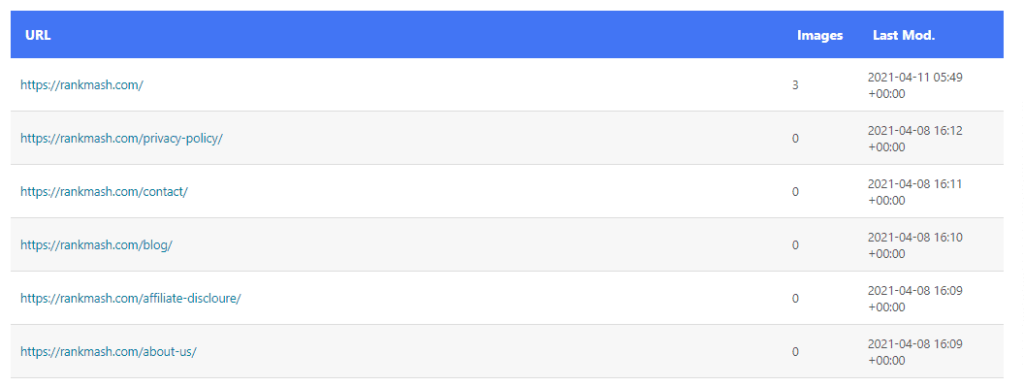
It’s generally located in the root directory like yourdomain.com/sitemap.xml. It includes all available links to web pages and that is made for visitors. However, some blog websites like WordPress blogs uses separate XML Sitemaps for Posts, Pages, Images, Videos as it’s created by SEO Plugins mentioned above.
Let’s have some looks into various types of XML Sitemaps.
1. Posts Sitemap
Sitemaps for posts are also formatted as XML Document to help Bots crawl all links of posts individually. This Sitemap type is generally used for Blog Websites. It includes links only to Posts/Articles of a blog/website. It’s not mandatory for all websites to have such a sitemap, except blog websites(considered as helpful in indexing).
2. Pages Sitemap
This individual Sitemap indicates all links of static pages of a blog/website like Post Sitemap. It’s also an XML Page, It’s also not mandatory for all websites to have pages on Sitemap, but there’s an exception in the case of SEO Practitioners.
3. Archives Sitemap
This Sitemap contains all links of archives of a website which is also an XML Page. It’s considered not helpful for blog websites because nobody wants to rank archive files on SERP. It’s just used to have a good website structure.
4. Categories Sitemap
For blogs/news websites with multiple categories, a separate Category Sitemap can be helpful for both Visitors & Crawlers to navigate through all various categories of a random blog website or news website.
5. Post Tags Sitemap
This Sitemap doesn’t make any sense for both SEO & Visitors(not in all cases) because Category Sitemap is enough to include all category types of a website. But there’s an exception, some websites have similar types of posts which help us in a particular process, but have multiple posts to do the same process in different ways or completely different tools.
Therefore, such websites use it to help crawlers/visitors in accessing all posts related to each other, eg. ‘how to create sitemap’ tag will include multiple posts with each title like ‘How to Create an XML Sitemap for WordPress,’ ‘How to Create a Posts Sitemap for WordPress’ ‘How to Create a Pages Sitemap for WordPress.’ So, all of these posts will be included in the ‘how to create sitemap‘ tag.
So visitors who would like to see all of these processes of Sitemaps, can simply go through the mentioned tag. And Crawlers will also index all Tags with Post-Tags Sitemap.
6. News Sitemap
It’s mandatory to have a News Sitemap for News Websites as Search Engines will index the new posts immediately with news sitemap because generally, blog posts take much time to get indexed in Search Engines. News Sitemaps are always fetched within a little time interval for indexing any newly published news.
7. Author Sitemap
Some websites have multiple categories for readers, so such websites are generally run by multiple authors. Such sites have a separate Author Sitemap, and it contains the names of all authors of that site. Even some websites run by a single person, also have an Author Sitemap containing the name of that single author/admin.
8. Images Sitemap
Images Sitemaps are used to gather all links of image files of a website/blog in a single place. If a blog/website uses an Image Sitemap, Search Engines will index image files of a site separately along with your webpages. It’s called a good SEO Practice to display and rank images on SERP like Google Image Search.
9. Videos Sitemap
Like Image Sitemaps, a website containing Video Files, uses a separate Video Sitemap which contains all links of video files hosted on the domain of that website. It’s also considered as a good SEO Practice for Video Content Websites. Like Image Sitemap helps in ranking on Google Image Search Results, it helps videos to appear and rank on SERP.
We’ve discussed XML Sitemaps above, and all of them are familiar with each other and can be submitted to Search Engines for a website/blog, and it’s a good SEO Practice. These Sitemaps can be clearly readable for normal visitors also because Most WordPress websites(with Yoast SEO or RankMath Plugin) use CSS Files with XML to make their sitemaps user-friendly too.
Now we’ll discuss ATOM & RSS Sitemaps.
2. ATOM & RSS Sitemap
Atom Sitemaps are now considered as a traditional indexing technique, though it’s very powerful and evergreen. ATM & RSS Feeds are used for fetching and moving content from one website to another website. And these two feeds are used as Sitemaps also. Atom Sitemaps are also based on XML encoding, but it has a different structure as compared to Normal XML Sitemaps.
It helps new updates and changes in posts of a blog/website to get noticed by Search Engines quickly. ATOM & RSS Sitemaps are very familiar with each other; they just have some different tags in structure. Most websites usually use for Faster Indexing than normal XML Sitemap.
Here's Are Some Differences Between XML Sitemaps & ATOM/RSS :
1. XML Sitemaps contain a bunch of URLs of a website, while ATOM/RSS Sitemaps describes recent changes of a particular website.
2. XML Sitemaps are usually large; they can contain a set of maximum 50,000 URLs or a maximum file size of 10MB(Uncompressed). On another hand, ATOM/RSS Sitemaps are small in size and capable of containing 500 URLs, so some websites submit multiple feed sitemaps to Search Engines to include all posts in their sitemaps.
3. Normal XML Sitemaps are downloaded in a long interval, and must be pinged to Search Engines Bots to inform them about new posts, while ATOM/RSS Sitemaps are generally downloaded within small intervals.
These all sitemap types mentioned above, are used for Search Engines to index web pages in a good manner separately. Basically it’s a good SEO Practice. Read more about Sitemaps efficiently on the official blog of Google Search Central
Now Lets Look On Other Type Of Sitemap
1. HTML Sitemap
HTML is a computer language that is used for building web pages. Most web pages are built on HTML. Like web pages, Sitemaps also can be written in HTML and designed with CSS for a user-friendly interface. HTML Sitemaps are generally created for normal visitors, not for crawlers. Though HTML Sitemaps can help Search Engines Crawlers to discover non-indexed URLs if the HTML Sitemap is indexable and is using the ‘nofollow’ tag.
2. PHP Sitemap
PHP is also a language used for making websites functional. Like HTML, Sitemaps can be made in PHP web pages also. It’s not about structure; generally, Sitemaps are automatically updated with new URLs for WordPress, Blogger, etc. But for custom websites, they’ll need to write codes to fetch data from the back-end. So, they can use PHP to write sitemaps for automatic data movement from the back-end. But it’s also written in HTML and CSS, but for the back-end, PHP is used. So, the file type of such sitemaps should be ‘.php.’ And the indexing conditions are the same as previously mentioned in the HTML Sitemap.
3. Text Sitemap
Text Sitemaps are simple, manually written sitemap types rarely used for websites. It’s just a ‘.txt’ file containing URLs, and it can’t be designed with CSS like HTML, XML & PHP Sitemaps. It’s used both for visitors and crawlers. And there is no condition for crawlers to follow the links and index them, because it’s not a web page, and doesn’t have any robots tags to instruct the crawlers.
The ‘nofollow’ robots tag orders crawlers not to follow and visit any links mentioned in the web page. So, in such cases, HTML Sitemaps are only for normal visitors to provide them with good navigation. You can read about robots tags from here.
Possible Ways to Find Out Sitemaps
Now we’re going to see all possible ways to find Sitemaps of any website, whether it’s a WordPress Blog or built on any other CMS like Blogger or any custom-coded website. Let’s start with Various XML Sitemaps.
First of all, we’ll need to figure out which CMS the website/blog is using. In this scenario, we can use a tool called CMS Detect. It’s a free tool, and can easily tell you which CMS the website is using or a custom-built website. After you know this, you’ll have to use the techniques mentioned below.
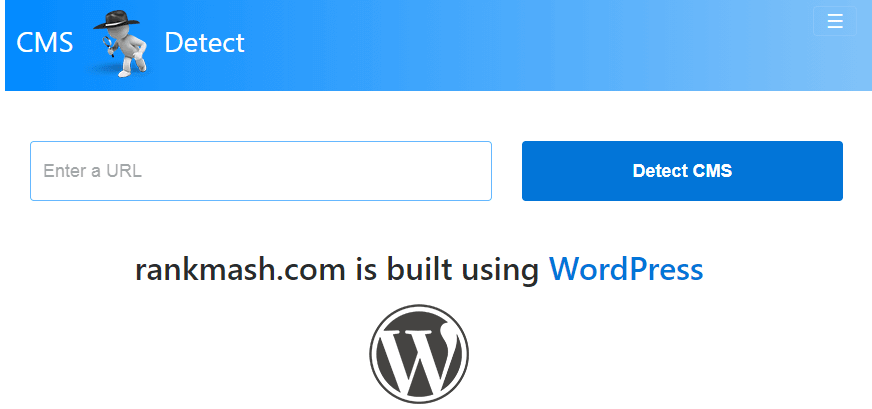
1. Manually Check Common Sitemap Locations
Most blogs/websites use WordPress, and use Yoast or RankMath SEO Plugins. So, they automatically create and submit XML Sitemaps to Search Engines. It’s gonna be easier to find Sitemaps of a WordPress Blog using Yoast/RankMath Plugin.
Here are the most common locations of Sitemaps are :
● domain.xyz/wp-sitemap.xml (Auto-Generated by WordPress)
● domain.xyz/sitemap.xml
● domain.xyz/sitemap1.xml (in case of multiple sitemaps, it’ll be first)
● domain.xyz/sitemap_index.xml
● domain.xyz/sitemap/ (can be redirected to /sitemap.xml or /sitemap_index.xml etc.)
● domain.xyz/sitemapindex.xml
● domain.xyz/sitemap-index.xml
● domain.xyz/sitemap/index.xml (using subfolder to store multiple sitemaps)
Don’t forget to add ‘HTTPS’ and ‘www‘ if the website is using them. And you can try adding ‘.gz‘ after all the locations/URLs mentioned above. It’s used if the website uses GZip Compression for sitemaps or all web pages.
In the case of our website, it’s built on WordPress, and using RankMath SEO Plugin. And Its Sitemap is located on ‘https://rankmash.com/sitemap_index.xml’ and if someone searches for ‘https://rankmash.com/sitemap.xml,’ then it’ll be redirected to this /sitemap_index.xml. You can see the screenshot of our Sitemap. It contains two Sitemap URLs of Posts Sitemap and Pages Sitemap. Anyone can see all of my sitemaps easily through my main XML Sitemap.
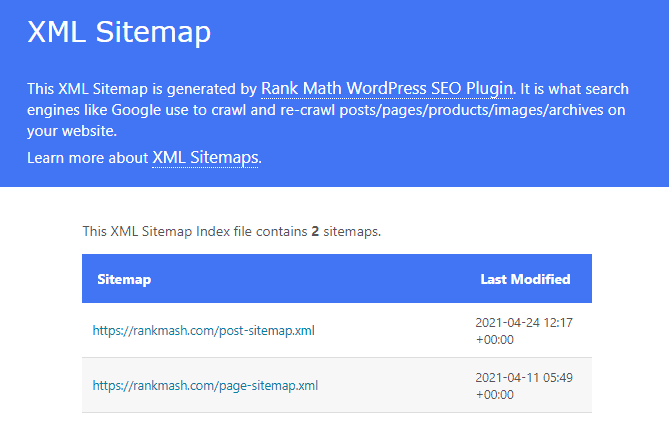
But in case, the website is using Sitemaps manually, then the possible chances are mentioned below separately for each Sitemaps.
Possible Locations of Posts Sitemap
● domain.xyz/post-sitemap.xml
● domain.xyz/post_sitemap.xml
● domain.xyz/posts-sitemap.xml
● domain.xyz/posts_sitemap.xml
● domain.xyz/postsitemap.xml (Rare Chances)
● domain.xyz/sitemap/post.xml
● domain.xyz/sitemap/posts.xml
Possible Locations of Pages Sitemap
● domain.xyz/page-sitemap.xml
● domain.xyz/page_sitemap.xml
● domain.xyz/pages-sitemap.xml
● domain.xyz/pages_sitemap.xml
● domain.xyz/pagesitemap.xml (Rare Chances)
● domain.xyz/sitemap/page.xml
● domain.xyz/sitemap/pages.xml
Possible Locations of Categories Sitemap
● domain.xyz/category-sitemap.xml
● domain.xyz/category_sitemap.xml
● domain.xyz/categories-sitemap.xml
● domain.xyz/categories_sitemap.xml
● domain.xyz/categorysitemap.xml (Rare Chances)
● domain.xyz/sitemap/category.xml
● domain.xyz/sitemap/categories.xml
Possible Locations of Post Tags Sitemap
● domain.xyz/post-tag-sitemap.xml
● domain.xyz/post-tags-sitemap.xml
● domain.xyz/post_tag-sitemap.xml
● domain.xyz/post_tags-sitemap.xml
● domain.xyz/post_tag_sitemap.xml
● domain.xyz/post_tags_sitemap.xml
● domain.xyz/post-tag_sitemap.xml
● domain.xyz/post-tags_sitemap.xml
● domain.xyz/posttagsitemap.xml (Very Very Rare Chance)
● domain.xyz/sitemap/post-tag.xml
● domain.xyz/sitemap/post_tag.xml
● domain.xyz/sitemap/post-tags.xml
● domain.xyz/sitemap/post_tags.xml
● domain.xyz/tag-sitemap.xml
● domain.xyz/tags-sitemap.xml
● domain.xyz/tag_sitemap.xml
● domain.xyz/tags_sitemap.xml
I know, the possibilities mentioned above seem to be very weird. But it’s true that the website creator can keep the name of his XML Sitemaps whatever he wants. So, I have mentioned all of the possibilities.
Possible Locations of News Sitemap
● domain.xyz/news-sitemap.xml
● domain.xyz/news_sitemap.xml
● domain.xyz/newssitemap.xml (it’s very rare )
● domain.xyz/sitemap/news.xml
Possible Locations of Author Sitemap
● domain.xyz/author-sitemap.xml
● domain.xyz/author_sitemap.xml
● domain.xyz/authors-sitemap.xml
● domain.xyz/authors_sitemap.xml
● domain.xyz/authorsitemap.xml (Rare Chances)
● domain.xyz/sitemap/author.xml
● domain.xyz/sitemap/authors.xml
Possible Locations of Images Sitemap
● domain.xyz/image-sitemap.xml
● domain.xyz/image_sitemap.xml
● domain.xyz/images-sitemap.xml
● domain.xyz/images_sitemap.xml
● domain.xyz/imagesitemap.xml (Rare Chances)
● domain.xyz/sitemap/image.xml
● domain.xyz/sitemap/images.xml
Also try with adding ‘.gz’ after all of the URLs mentioned above because the website can use GZip Compression.
Possible Locations of Videos Sitemap
● domain.xyz/video-sitemap.xml
● domain.xyz/video_sitemap.xml
● domain.xyz/videos-sitemap.xml
● domain.xyz/videos_sitemap.xml
● domain.xyz/videositemap.xml (Rare Chances)
● domain.xyz/sitemap/video.xml
● domain.xyz/sitemap/videos.xml
Ways to Find ATOM/RSS Sitemaps
As I mentioned earlier, some websites can use their feeds as a sitemap also.
So, try with these URLs :
● domain.xyz/rss/
● domain.xyz/atom/
● domain.xyz/rss.xml
● domain.xyz/atom.xml
● domain.xyz/rss-feed.xml
● domain.xyz/atom-feed.xml
● domain.xyz/sitemap/rss.xml
● domain.xyz/sitemap/atom.xml
We can find the HTML or PHP Sitemap of the website easily, because the website creator has created that for visitors. So, it should be mentioned in the website, check out the footer or the menu to find the HTML or PHP Sitemap. If still you can’t find that, then try out these links mentioned below.
Ways to Find HTML Sitemaps
● domain.xyz/sitemap.html
● domain.xyz/sitemap/
● domain.xyz/sitemap_index.html
● domain.xyz/sitemap-index.html
● domain.xyz/pages/sitemap.html
● domain.xyz/pages/sitemap_index.html
● domain.xyz/pages/sitemap-index.html
● domain.xyz/p/sitemap.html
● domain.xyz/p/sitemap_index.html
● domain.xyz/p/sitemap-index.html
Ways to Find PHP Sitemaps
● domain.xyz/sitemap.php
● domain.xyz/sitemap/
● domain.xyz/sitemap_index.php
● domain.xyz/sitemap-index.php
● domain.xyz/pages/sitemap.php
● domain.xyz/pages/sitemap_index.php
● domain.xyz/pages/sitemap-index.php
● domain.xyz/p/sitemap.php
● domain.xyz/p/sitemap_index.php
● domain.xyz/p/sitemap-index.php
Ways to Find Text Sitemaps
● domain.xyz/sitemap.txt
● domain.xyz/sitemap_index.txt
● domain.xyz/sitemap-index.txt
Here we’ve covered all possible locations where a website’s all types of Sitemap can be located, though some of them are really weird. Now we’re gonna see some hacks or tricks whatever you say. We’ll use it to find out sitemaps easily without trying with multiple URLs mentioned above, still they’ll be helpful if these tricks don’t work.
2. Check The Robots.txt File
Every website has a separate robots.txt file that instructs Bots or Crawlers to index or exclude multiple URLs or Directories. It usually contains links to the Sitemap or multiple Sitemaps of a website. We can find the Sitemap of any website through the robots.txt file, if it’s mentioned there in the Sitemap.
Steps to Check Sitemaps in Robots.TXT
● First, open the website of which you want the Sitemap in your browser. I’m showing you the way with an example of my website, ‘rankmash.com.’
● Then add ‘/robots.txt’ after the domain name. Just like, ‘https://rankmash.com/robots.txt.’
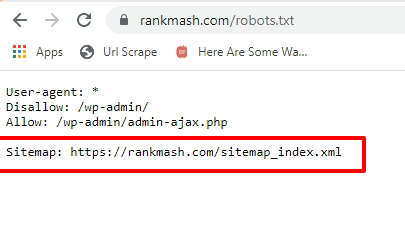
● Now, you can notice the red line in the image above. It’s our Sitemap. Now it’s the only Sitemap our website has.
But some websites use Various Sitemaps mentioned above. And some website owners don’t add their sitemap link in the robots.txt file. So, you can try the tricks mentioned below.
3. Use SEO Site Checkup Tool
You can also find a sitemap through the seo site checker tool.
Url of the tool – https://seositecheckup.com/tools/sitemap-test
● First of all, enter the url address of your website.
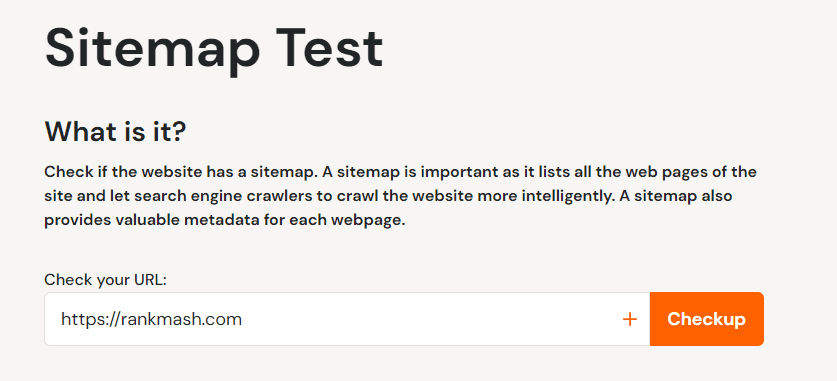
● Then click on a checkup and the result will be available within a few seconds.
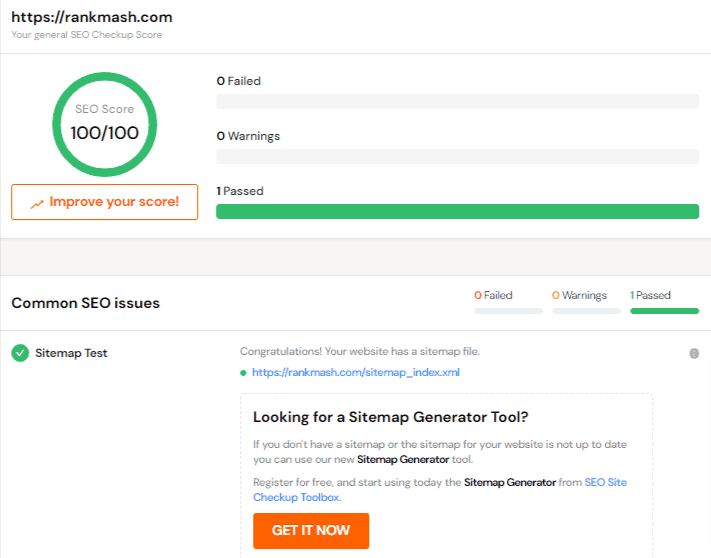
3. Use Google Search Operators
Google is the largest Search Engine in the world. So, every website owner wants his website properly indexed on Google. Therefore, our first priority will be Google. Well, let’s see the steps. If we want to find all XML Sitemaps of a website, then you’ll have to use these search parameters:
● site: (domain name)
● ext: or filetype: (sitemap type: xml, txt, html)
● inurl: (keyword we want to search in the URLs; Sitemap)
If we want to find the xml sitemap of our website, we’ll search on type the following phrase in Google Search Bar:
site:rankmash.com filetype:xml inurl:sitemap
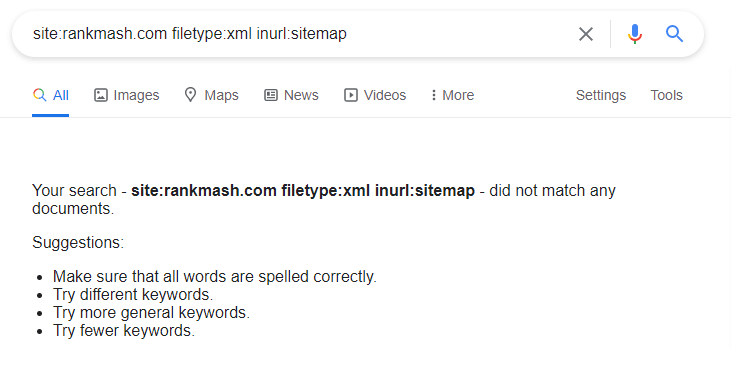
As you can see above, that our XML Sitemap isn’t being shown on SERP, because our sitemap file is using a ‘noindex, follow’ tag as I’m using RankMath Plugin. RankMath automatically adds a ‘noindex, follow’ tag to the sitemap file, that’s why it’s not indexed in Google. This method also doesn’t work properly, so you’ll have to try all the possible locations mentioned above separately for each sitemap type.
OR
site:semrush.com ext:xml inurl:sitemap
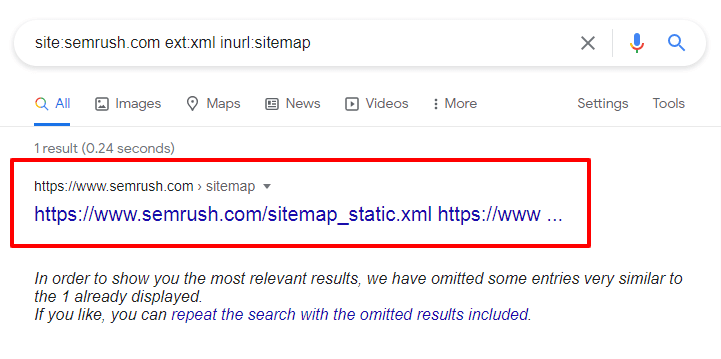
As you can see Semrush Sitemap shows in SERP.
And if you want to find the TXT sitemap or HTML/PHP of the website, then replace the ‘xml’ word with ‘html/php/txt,’ whatever you want.
Now we’ll see all Default Sitemap Locations of many popular CMS like Joomla, Shopify, Magento, Wix and Squarespace, etc. The default sitemap location of Joomla, Shopify, Magento, Magento, Wix and SquareSpace, is ‘/sitemap.xml’.
But Wix has other URL Paths for different sitemaps, you can find the sitemap paths of Wix from here.
Alright, first of all, try the hacks & tricks like robots.txt & Google Search Operators, if you can’t find your desired sitemaps, then try the possible URLs/Paths one by one. I’m sure this article on Sitemap has helped you a lot.
Thanks for reading. See you again 🙂
Also Read – How To Add Sitemap in Google Search Console
Occasional emails that will help you deliver value via SEO.
